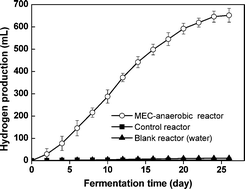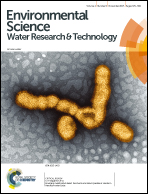Enhancement of sludge decomposition and hydrogen production from waste activated sludge in a microbial electrolysis cell with cheap electrodes†
Abstract
Low hydrogen production from anaerobic digestion of sludge has greatly limited the application of biological hydrogen-producing technology. An Fe/graphite electrode was installed into an anaerobic digester to enhance the hydrogen production from waste sludge in this study. The electrode accelerated the decomposition of the sludge, and the production of short-chain fatty acids was 3.5 folds of that in a control anaerobic reactor with no electrode. The hydrogen production was 90.6 mL gVSS−1, while it was almost undetectable in the control. The results suggested that the hydrogen was produced from the cathodic reduction of H+ coupling with the anodic oxidation of sludge. The excessive consumption of the cathodic H+ drove the pH up to 9.2–9.5 in the electric-anaerobic system which inevitably inhibited the occurrence of methanogenesis. This led to quite low methane production in this electric-anaerobic system. The microbial analysis showed that exoelectrogens were enriched in the presence of an Fe electrode. It catalyzed the anodic oxidation of the sludge to produce more electrons for the cathodic hydrogen production. Raising the voltage supply boosted the H2 production, but the net energy output was obtained at 0.3 and 0.6 V.


 Please wait while we load your content...
Please wait while we load your content...